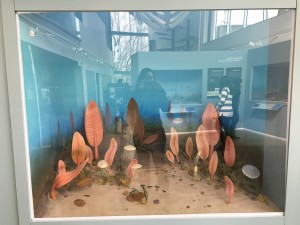Last Saturday, I took a trip with the Rose Scholars to see the Museum of the Earth, located just close to Cayuga Medical Center. To be honest, I had no idea that this place existed, but it was a small little treasure trove of information in the outskirts of Ithaca. The museum was created by Cornell Professor Gilbert Harris in 1932, originally founded as the Paleontological Research Institution as a place to further research and learning in paleontology. Over the years, it’s been open to the public as a museum, and especially is very kid friendly.
Our tour guide took us through an overview of the historical eras — about 4.6 billion years’ worth. To keep things interesting, she handed each of us a small fossil and by the end of the tour, each of us would get to figure out if we survived or not (I kind of figured that my dinosaur bone would not be here today).
My favorite part of the trip was being able to see many of the dioramas and figures that were transported from the Smithsonian Institute. Once we had reached the Jurassic era (and my dinosaur bone was rendered extinct after the mass extinction), we saw a large figure of a Stegosaurus made in 1904 out of paper mache. I loved this not because of the authenticity of it (because I wouldn’t be the one to know what a dinosaur looks like), but because of the creativity that went into making it. 
I also loved the dioramas of some of the early marine life in the Silurian Sea, dating from about 410 to 430 million years ago. These were also transported from the Smithsonian.




Sierra, thank you for sharing your experience at the Museum of the Earth. I enjoyed seeing the pictures that you posted because I think that every museum has its own way of showcasing its artifacts. I liked that you highlighted the dioramas because it can be difficult for us to imagine what these creatures and the landscape looked like so many hundreds of millions of years ago. As someone who is very intrigued by marine life, I appreciated the depictions of early marine life in the Silurian Sea. I would be curious to know more about the process that paleontologists and archaeologists go through in order to establish what these paper mache creatures and dioramas should look like for the general public to see.